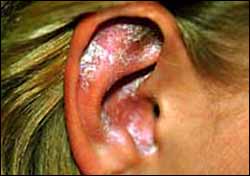Autoimmune and genetic diseases

Autoimmune diseases are quite complex and this is due to the fact that these illnesses do not depend on just one gene. Thus, in order to find a suitable treatment, it is not enough to identify a gene involved in the development of the disease – each and every one has to be identified. To this end, a number of strategies have been design; for example, many geneticists have begun to analyse the genetic differences between healthy individuals and ill ones. A team at the Leioa campus of the University of the Basque Country are using this very strategy in the study of lupus – an autoimmune disease.
Differences in the markers
All of us are genetically very similar, almost the same, in fact. If two people are chosen at random, 99.9% of their genome is identical. Even so, we observe that these two persons have differences, for example, physical aspect or susceptibility to certain illnesses. Some of these differences are found in the genome markers.
The markers (single nucleotide polymorphism or SNP) are usually located at concrete points along the genome and contain information about the genes in close proximity to these. If the genome were a highway, the markers would be milestones; the genome has thousands of them.
Each one of these SNP may be represented by a letter corresponding to the marker nucleotide. There are four nucleotides in the DNA: adenine, cytosine, guanine and thymine. A number of studies have already identified the relation between certain markers ad a number of diseases. Moreover, the markers provide a way of analysing the genome as a whole and, thereby, in the case of autoimmune illnesses, all the genes involved can be found.
In this analysis, the differences between the markers of healthy and ill people are studied. If, in a marker, adenine is normally present in both healthy and ill individuals, then it is clear that there is no difference here and this marker is not one that defines the illness. On the other hand, if thymine appears instead of adenine in the sick individuals, this marker may be related to the disease. Once these markers have been identified, the search for those genes involved begins close to these markers.
But, in order to analyse the differences between the markers, these have to be first identified. This is the work being undertaken at the Leioa campus.
Identification of markers
In order to identify the markers of an individual person, a sample of their blood is required. From this sample the individual’s DNA is extracted in order to analyse the markers. There are a number of techniques available to this end but normally, depending on the nucleotide, it is visualised in one colour or another. So, depending on the colour, the nucleotide of each marker is identified.
These identifications have to be repeated until a data base of markers of healthy and ill persons is completed. Finally, with the help of computers, the markers which define the difference between both groups of individuals are established. But the work is not finished there. Given that these results still have a long road to travel to find the genes involved in the disease and to find treatment for its cure.
Media Contact
All latest news from the category: Life Sciences and Chemistry
Articles and reports from the Life Sciences and chemistry area deal with applied and basic research into modern biology, chemistry and human medicine.
Valuable information can be found on a range of life sciences fields including bacteriology, biochemistry, bionics, bioinformatics, biophysics, biotechnology, genetics, geobotany, human biology, marine biology, microbiology, molecular biology, cellular biology, zoology, bioinorganic chemistry, microchemistry and environmental chemistry.
Newest articles

First-of-its-kind study uses remote sensing to monitor plastic debris in rivers and lakes
Remote sensing creates a cost-effective solution to monitoring plastic pollution. A first-of-its-kind study from researchers at the University of Minnesota Twin Cities shows how remote sensing can help monitor and…

Laser-based artificial neuron mimics nerve cell functions at lightning speed
With a processing speed a billion times faster than nature, chip-based laser neuron could help advance AI tasks such as pattern recognition and sequence prediction. Researchers have developed a laser-based…

Optimising the processing of plastic waste
Just one look in the yellow bin reveals a colourful jumble of different types of plastic. However, the purer and more uniform plastic waste is, the easier it is to…



